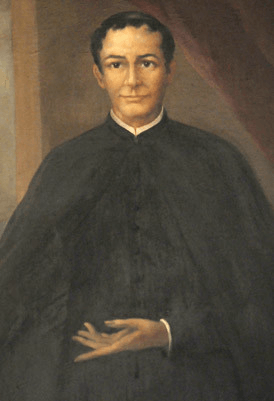Francisco Xavier Bogarin facts for kids
Francisco Javier Bogarín was a Catholic priest and teacher. He was born in 1763 in Carapeguá, a town in Paraguay. He played an important part in Paraguay's journey to become an independent country. In 1811, he was even a member of the group that governed Paraguay for a few months.
Contents
Early Life and Education
Francisco Javier Bogarín's parents were Francisco Bogarín and María Paula Villamayor. He went to the National University of Córdoba to study. There, he met important people like Juan José Paso and Mariano Medrano, who later helped Argentina become independent.
He finished his studies in Theology and became a priest in 1784. After that, he returned to Paraguay.
Working in the Church
Back in Asunción, Bogarín became the Secretary for Bishop Nicholas Videla del Pino. He also taught at the San Carlos Seminary College. In 1796, he became the head of Philosophy studies there.
At that time, the Church was very involved in politics. Priests were often some of the most educated people. This meant they knew about new ideas and often played a role in important decisions.
Path to Independence
In 1810, the governor of Paraguay, Bernardo de Velasco, called a special meeting. This was after the May Revolution happened in Buenos Aires, Argentina. At this meeting, the leaders in Paraguay said they were still loyal to King Ferdinand VII of Spain.
This decision led to a fight known as the Paraguay campaign. Paraguayan troops won against forces sent from Buenos Aires. This victory, along with worries that Governor Velasco might ask for help from Portugal, led to the May 14, 1811 Revolution. This revolution was the start of Paraguay's independence.
Joining the Independence Movement
On the night of May 14, 1811, military officers faced Governor Velasco. They successfully created a new group to rule. This group had three members: Governor Velasco, José Gaspar Rodríguez de Francia, and Captain Juan Valeriano de Zeballos.
Key Leaders of Paraguayan Independence
Many brave people helped Paraguay become independent. Here are some of the important leaders:
- Fulgencio Yegros
- Pedro Juan Caballero
- Vicente Ignacio Iturbe
- Mauricio José Troche
- Antonio Tomás Yegros
- Fernando de la Mora
- Mariano Antonio Molas
- Juan Bautista Rivarola
After Independence Was Declared
From June 17 to June 20, 1811, the first National Congress of Paraguay met. This Congress created a new five-person group to govern the country. It was called the Junta Superior Gubernativa. Fulgencio Yegros led this group, and Francisco Javier Bogarín was included as a representative of the clergy (church leaders).
The First Governing Junta
The new governing group started its work on June 20. One of the first things they did was send a message to Buenos Aires on July 20. In this message, they clearly stated that Paraguay wanted to be an independent country.
Later, José Gaspar Rodríguez de Francia left the governing group. He said it was because the military was becoming too powerful. On August 6, the other members of the group sent a letter asking him to come back. Bogarín did not sign this letter.
Soon after, Bogarín had disagreements with the rest of the governing group. At the request of Yegros, he was removed from the group on September 2, 1811. Some people believe that Francia used this situation to reduce the influence of church leaders in the government. After this, Bogarín left politics for good. What happened to him after that, including when he died, is not known.
See also
 In Spanish: Francisco Javier Bogarín para niños
In Spanish: Francisco Javier Bogarín para niños


